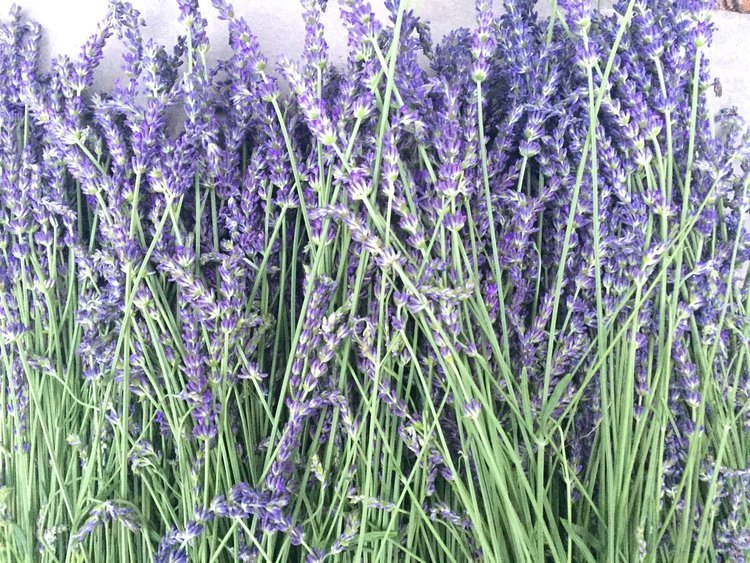Lavender (Lavandula angustifolia)
Photo by Ilana Sobo
Lavender
Lavender (Lavandula angustifolia)
The Flower of Peace and Calm
Lavender has been cherished for centuries as a symbol of tranquility, protection, and stress support . Its delicate purple blooms and intoxicating fragrance have made it a staple in gardens, medicine cabinets, and sacred rituals. From ancient Egyptian embalming practices to medieval herbal remedies and modern aromatherapy, lavender remains one of the most versatile and beloved plants in herbalism.
Traditionally, lavender has been used for its calming effects on the nervous system. It is a well-known remedy for stress, anxiety, and insomnia, often enjoyed as a tea, tincture, or essential oil. Its sedative properties help to relax the mind, ease tension headaches, and support restful sleep. Herbalists also use lavender as a gentle digestive aid, soothing bloating, cramps, and indigestion. The plant’s antiseptic and anti-inflammatory qualities make it an excellent choice for wound healing, burns, and skin irritations. A staple in herbal first-aid kits, lavender oil is frequently applied to minor cuts, bug bites, and sunburns to promote healing and reduce pain.
In folklore, lavender has long been associated with protection and love. It was believed to ward off evil spirits, illness, and even the plague, often bundled and hung in doorways or burned as incense. During the Victorian era, lavender symbolized purity and devotion, frequently included in love spells and bridal bouquets. Its name is derived from the Latin lavare, meaning “to wash,” as the plant was commonly used in bathing rituals to cleanse both the body and spirit.
In the Garden
In the garden, lavender is not only a visual and aromatic delight but also a powerful companion plant. Its strong scent deters pests such as mosquitoes, moths, and deer while attracting beneficial pollinators. Honeybees, bumblebees, and butterflies, particularly Painted Ladies and Swallowtails, adore lavender’s nectar-rich flowers. Hummingbirds will also visit lavender when other nectar sources are scarce. The plant thrives in full sun, preferring well-drained, sandy or loamy soil with a slightly alkaline pH. It is drought-tolerant once established, making it an excellent choice for xeriscaping and dry gardens.
To keep lavender healthy and productive, regular pruning is essential. In early spring, dead or woody stems should be trimmed back to encourage new growth. After the first bloom in summer, cutting back spent flowers can stimulate a second, smaller flowering. A hard pruning in late summer to early fall—trimming about one-third of the plant’s height—helps maintain its shape and prevents it from becoming too woody. However, care must be taken not to cut into old wood, as lavender struggles to regenerate from mature stems.
Varieties of Lavender
Here’s a breakdown of some of the best lavender varieties along with their USDA planting zones:
English Lavender (Lavandula angustifolia)
Best for: Medicinal and Culinary use, fragrance, essential oil, ornamental gardens
USDA Zones: 5-9
Popular Varieties:
Hidcote – Compact, deep purple flowers, great for borders (Zones 5-9)
Munstead – Hardy, early bloomer with soft lavender-blue flowers (Zones 5-9)
Royal Velvet – Long-stemmed, highly fragrant, excellent for bouquets (Zones 5-9)
French Lavender (Lavandula dentata)
Best for: Mild climates, ornamental gardens, container planting
USDA Zones: 8-11
Features:
More tolerant of heat and humidity than English lavender
Distinctive serrated leaves with a lighter scent
Blooms nearly year-round in warm climates
Spanish Lavender (Lavandula stoechas)
Best for: Hot, dry climates, pollinator gardens
USDA Zones: 7-10
Popular Varieties:
Anouk – Deep purple flowers with butterfly-like bracts (Zones 7-10)
Ballerina – White and purple flowers with a strong scent (Zones 7-10)
Silver Anouk – Silvery foliage with deep purple blooms (Zones 7-10)
Lavandin (Lavandula × intermedia)
Best for: High essential oil yield, large garden displays, crafting
USDA Zones: 5-9
Popular Varieties:
Grosso – The most widely grown for essential oil, large, deep purple blooms (Zones 5-9)
Provence – Tall, highly fragrant, excellent for drying (Zones 5-9)
Phenomenal – Extremely hardy, resistant to heat, humidity, and cold (Zones 5-9)
If you live in colder regions (Zones 3-4), lavender can be grown in containers and brought indoors during winter. In hotter, humid climates (Zones 10-11), French or Spanish lavender tends to perform better than English varieties.
Pollinators and Beneficial Insects
Lavender is highly attractive to a variety of pollinators, making it a valuable addition to pollinator-friendly gardens. Bees, including honeybees and bumblebees, frequently visit lavender for its nectar. Butterflies such as the Painted Lady and Swallowtail are also drawn to its blooms. Occasionally, hummingbirds will feed on lavender’s nectar when other floral sources are limited. By planting lavender, gardeners can support these beneficial creatures while enjoying a fragrant and visually stunning landscape.
Companion Planting with Lavender
Lavender is an excellent companion plant, as its strong scent helps deter pests while attracting pollinators. Some of the best companion plants include:
Rosemary, Thyme, and Oregano – These Mediterranean herbs share similar soil and sun requirements, creating a cohesive, low-maintenance herb garden.
Sage – Another drought-tolerant herb that pairs well with lavender, enhancing both visual appeal and pollinator attraction.
Echinacea (Coneflower) – Their vibrant blooms complement lavender while supporting pollinators.
Yarrow – A hardy perennial that attracts beneficial insects and thrives in similar growing conditions.
Roses – Lavender’s aromatic qualities can help deter aphids and other pests that commonly affect roses.
Marigolds – These bright flowers naturally repel unwanted insects and provide a beautiful contrast to lavender’s purple hues.
Lavender should be planted away from moisture-loving plants such as mint, as its preference for dry, well-draining soil does not match their needs.
Lavender remains one of the most beloved plants in gardens, herbal traditions, and aromatherapy. With its pollinator-friendly blooms, aromatic foliage, and adaptability to dry conditions, it is a valuable choice for any gardener looking to create a beautiful and beneficial landscape. Whether grown for its traditional uses, its ability to attract bees and butterflies, or simply its soothing fragrance, lavender continues to be a timeless botanical treasure.

